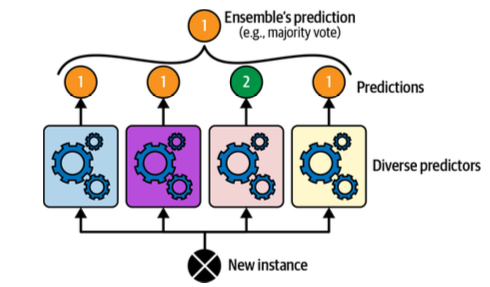Decision Trees and Random Forests¶
Prof. Forrest Davis
Apply a decision tree to new data¶
- Consider the following decision tree (from the book).
Question: Classify a new data point with the following values:
- petal length: 2.50cm
- petal width: 1.75cm
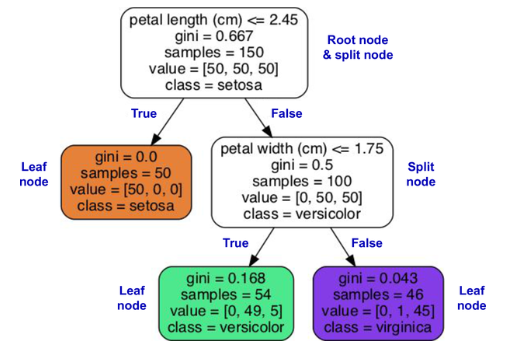
Answer: The point would be classified as veriscolor
Step One: A classification problem (our old friend, the bad plots)¶
- Consider the following figure.
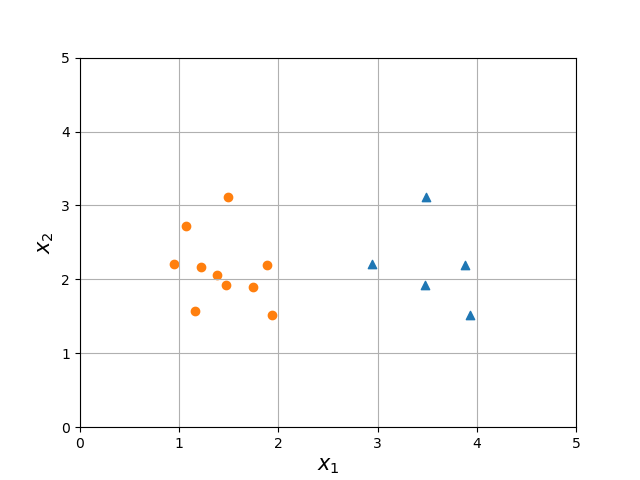
Question: Calculate the Gini impurity.
Hint: You can get the Gini impurity if you can answer the following question:
- What is the probability of classifying a point incorrectly (e.g., if I select a triangle, and I guessed based on the labels I know exist, what is the likelihood I misclassify a triangle)?
Answer
- Starting with the triangle class that I mispredict as circle
\begin{align} G_\textrm{triangle} &= P(\textrm{select triangle}) * (1 - P(\textrm{classify as triangle}))\\ &= \frac{5}{15} * (1-\frac{5}{15}) \\ &= \frac{2}{9} \end{align}
- Next up with the circle class that I mispredict as a triangle
\begin{align} G_\textrm{circle} &= P(\textrm{circle}) * (1 - P(\textrm{classify as circle}))\\ &= \frac{10}{15} * (1-\frac{10}{15}) \\ &= \frac{2}{9} \end{align}
- Total probability of misclassification is $\frac{4}{9} \approx 0.44$
- Notice it is less than $0.5$ why is that?
A note on the equation¶
- Above we use $G_\textrm{i} = \sum_{k=1}^n P_{i,k} (1 - P_{i,k})$ where $n$ is the number of output classes and $P_{i,k}$ is the probability of correctly guessing output $k$ (from the $n$ classes) at a node $i$ in the tree. Recall a node has some split of the data.
- The book instead uses $G_\textrm{i} = 1 - \sum_{k=1}^n P_{i,k}^2$
- These are equivalent:
\begin{align} G_\textrm{i} &= \sum_{k=1}^n P_{i,k} (1 - P_{i,k})\\ &= \sum_{k=1}^n P_{i,k} - P_{i,k}^2 \\ &= \sum_{k=1}^n P_{i,k} - \sum_{k=1}^n P_{i,k}^2 \\ &= 1 - \sum_{k=1}^n P_{i,k}^2 \\ \end{align}
Note $\sum_{k=1}^n P_{i,k}$ is 1 because, by fundmental assumption about probability, the total probability at a node $i$ for all of the classes must sum to 1.
Step Two: Apply Gini impurity¶
- Consider the following two potential decision boundaries:
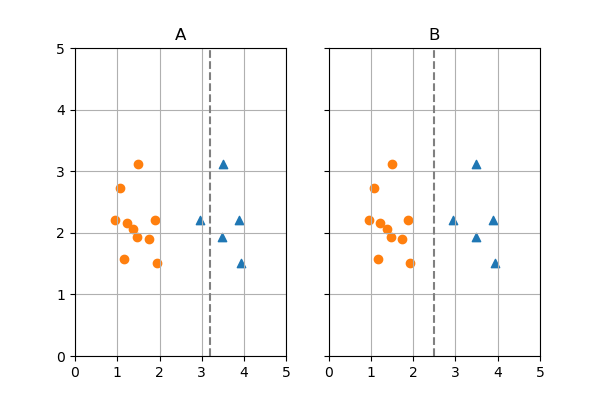
Question: Calculate the Gini impurity for the left and right regions for each decision boundary
Answer:
- Equation for Gini impurity
$$ G = 1 - \sum_{k=1}^K p_{k} ^2 $$
Where we have $K$ output classes
Let's start with A
The left side has a gini index of:
$$ G_\textrm{left A} = 1 - ((\frac{10}{11})^2 + (\frac{1}{11})^2) = 0.165 $$
- The right side has a gini index of:
$$ G_\textrm{right A} = 1 - ((\frac{0}{4})^2 + (\frac{4}{4})^2) = 0 $$
Next with B
The left side has a gini index of:
$$ G_\textrm{left B} = 1 - ((\frac{10}{10})^2 + (\frac{0}{10})^2) = 0 $$
- The right side has a gini index of:
$$ G_\textrm{right B} = 1 - ((\frac{0}{5})^2 + (\frac{5}{5})^2) = 0 $$
Question: Calculate the CART cost function value for both decision boundaries
Answer
- The cost function is as follows:
$$\textrm{Cost}_\textrm{threshold} = \frac{m_\textrm{left}}{m}G_\textrm{left} + \frac{m_\textrm{right}}{m}G_\textrm{right}$$
Where m is my total samples considered for this split and $G$ is gini impurity
For A
$$ \textrm{Cost}_\textrm{A} = \frac{11}{15} * 0.165 + \frac{4}{15}*0 = 0.121$$
- For B
$$ \textrm{Cost}_\textrm{A} = \frac{10}{15} * 0 + \frac{5}{15}*0 = 0$$
Question: How much information did I gain with each decision bounday?
Answer
- For A:
- $0.44 - 0.121 = 0.319$
- For B:
- $0.44 - 0 = 0.44$
- I gained the most information with B, so it wins!
Consider a binary classification task. Three decision boundaries with the following properties are generated. Determine their Gini values.
- All points belong to class 1
- Half of the points belong to class 1
- None of the points belong to class 1
Step Three: CART Algorithm Sketch¶
Guiding Questions:
- Sketch out the CART Algorithm
- Why is this algorithm greedy?
- What are possible stopping criteria?
Answers
- Calculate the Gini impurity for the entire dataset (e.g., impurity of the root node).
- For each input feature, calculate the Ginit impurity for all possible thresholds. The feature, threshold pair which has the minimum Gini impurity wins.
- Split the data based on the chosen feature, threshold pair. Create new nodes.
- Repeate 2 and 3, until some stopping criterai is met. Could be maximum tree depth, minimum data points in a leaf node, or a minimum reduction in impurity
Learning a decision tree for continuous data¶
- Given the following sample data, use the CART algorithm to learn a decision tree.
| Sample | F$_1$ | Y |
|---|---|---|
| 1 | 2.2 | 1 |
| 2 | 3.2 | 0 |
| 3 | 4.2 | 0 |
| 4 | 4.6 | 1 |
| 5 | 5.6 | 1 |
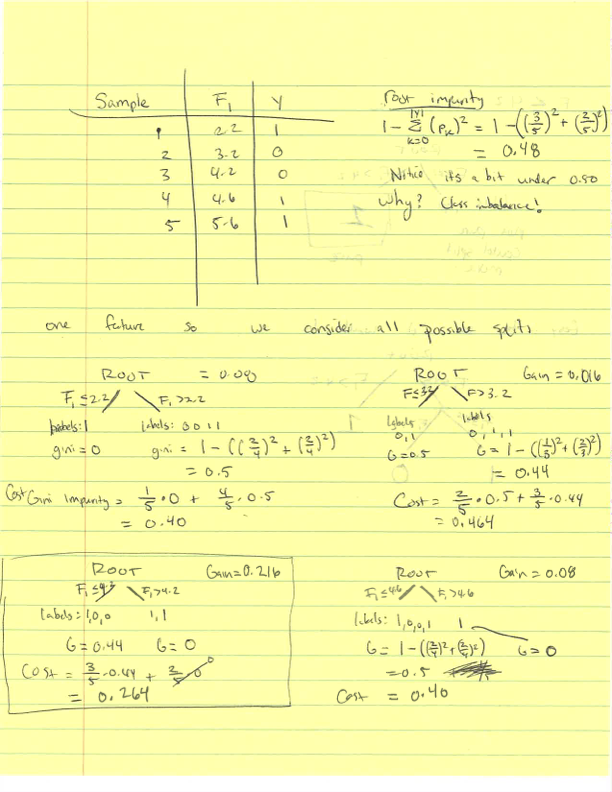
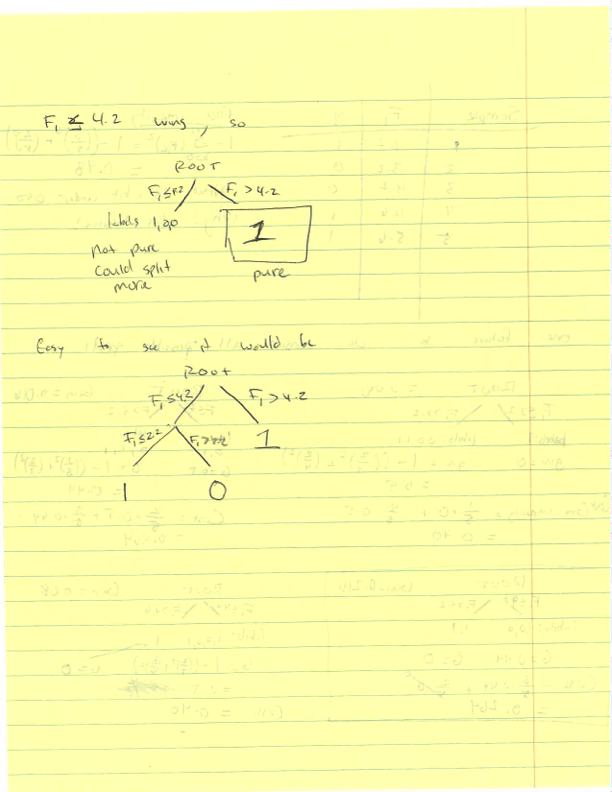
Learning a decision tree for non-binary categorical data¶
Question
- Given the following sample data, use the CART algorithm to learn a decision tree.
| Sample | F$_1$ | F$_2$ | Y |
|---|---|---|---|
| 1 | A | cat | 1 |
| 2 | B | cat | 1 |
| 3 | A | cookie | 0 |
| 4 | C | cookie | 0 |
| 5 | C | dog | 0 |
| 6 | B | dog | 1 |
| 7 | A | cat | 1 |
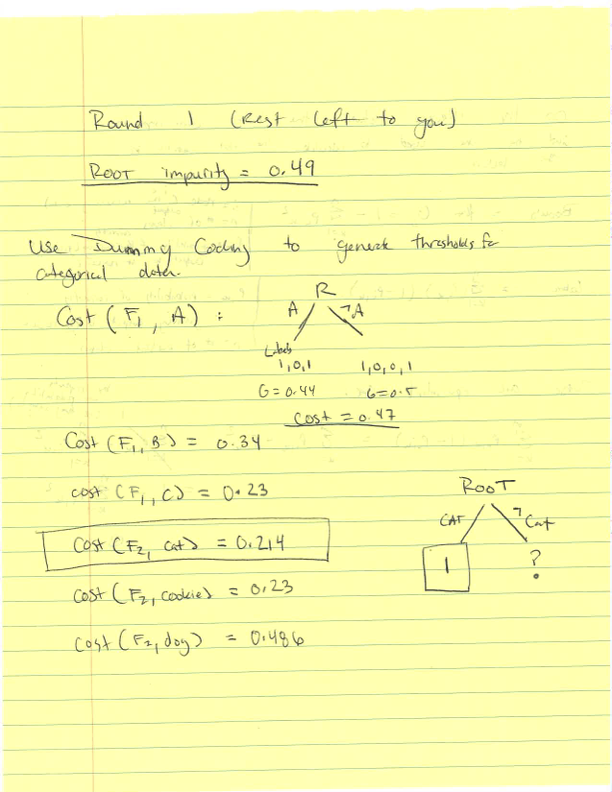
Limitations of Decision Trees¶
Question What are some limitations of decision trees?
Answer
- Our learning algorithm can proceed until all nodes are pure. Meaning, we can greatly overfit our data.
Random Forests, Ensemble Learning, and Voting Classifiers¶
- Random forests: train a bunch of decision trees on your data (adding in some randomness to ensure differences between each decision tree).
- Ensemble learning: train a bunch of models and use them all to make a prediction
- Voting Classifiers is one approach to ensemble learning.
